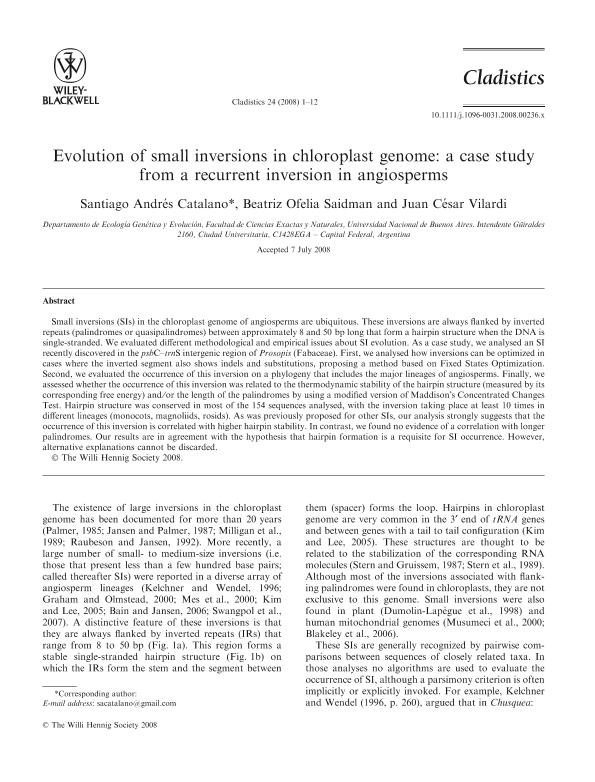Mostrar el registro sencillo del ítem
dc.contributor.author
Catalano, Santiago Andres

dc.contributor.author
Saidman, Beatriz Ofelia

dc.contributor.author
Vilardi, Juan Cesar

dc.date.available
2019-05-13T15:51:04Z
dc.date.issued
2009-02
dc.identifier.citation
Catalano, Santiago Andres; Saidman, Beatriz Ofelia; Vilardi, Juan Cesar; Evolution of small inversions in chloroplast genome: A case study from a recurrent inversion in angiosperms; Wiley Blackwell Publishing, Inc; Cladistics; 25; 1; 2-2009; 93-104
dc.identifier.issn
0748-3007
dc.identifier.uri
http://hdl.handle.net/11336/76155
dc.description.abstract
Small inversions (SIs) in the chloroplast genome of angiosperms are ubiquitous. These inversions are always flanked by inverted repeats (palindromes or quasipalindromes) between approximately 8 and 50 bp long that form a hairpin structure when the DNA is single-stranded. We evaluated different methodological and empirical issues about SI evolution. As a case study, we analysed an SI recently discovered in the psbC-trnS intergenic region of Prosopis (Fabaceae). First, we analysed how inversions can be optimized in cases where the inverted segment also shows indels and substitutions, proposing a method based on Fixed States Optimization. Second, we evaluated the occurrence of this inversion on a phylogeny that includes the major lineages of angiosperms. Finally, we assessed whether the occurrence of this inversion was related to the thermodynamic stability of the hairpin structure (measured by its corresponding free energy) and/or the length of the palindromes by using a modified version of Maddison's Concentrated Changes Test. Hairpin structure was conserved in most of the 154 sequences analysed, with the inversion taking place at least 10 times in different lineages (monocots, magnoliids, rosids). As was previously proposed for other SIs, our analysis strongly suggests that the occurrence of this inversion is correlated with higher hairpin stability. In contrast, we found no evidence of a correlation with longer palindromes. Our results are in agreement with the hypothesis that hairpin formation is a requisite for SI occurrence. However, alternative explanations cannot be discarded.
dc.format
application/pdf
dc.language.iso
eng
dc.publisher
Wiley Blackwell Publishing, Inc

dc.rights
info:eu-repo/semantics/openAccess
dc.rights.uri
https://creativecommons.org/licenses/by-nc-sa/2.5/ar/
dc.subject
Small Inversions
dc.subject
Chloroplast Genome
dc.subject
Angiosperms
dc.subject
Prosopis
dc.subject.classification
Otras Ciencias Biológicas

dc.subject.classification
Ciencias Biológicas

dc.subject.classification
CIENCIAS NATURALES Y EXACTAS

dc.title
Evolution of small inversions in chloroplast genome: A case study from a recurrent inversion in angiosperms
dc.type
info:eu-repo/semantics/article
dc.type
info:ar-repo/semantics/artículo
dc.type
info:eu-repo/semantics/publishedVersion
dc.date.updated
2019-04-23T17:52:37Z
dc.journal.volume
25
dc.journal.number
1
dc.journal.pagination
93-104
dc.journal.pais
Reino Unido

dc.journal.ciudad
Londres
dc.description.fil
Fil: Catalano, Santiago Andres. Consejo Nacional de Investigaciones Científicas y Técnicas. Centro Científico Tecnológico - Tucumán. Unidad Ejecutora Lillo; Argentina
dc.description.fil
Fil: Saidman, Beatriz Ofelia. Consejo Nacional de Investigaciones Científicas y Técnicas. Oficina de Coordinación Administrativa Ciudad Universitaria. Instituto de Ecología, Genética y Evolución de Buenos Aires. Universidad de Buenos Aires. Facultad de Ciencias Exactas y Naturales. Instituto de Ecología, Genética y Evolución de Buenos Aires; Argentina
dc.description.fil
Fil: Vilardi, Juan Cesar. Consejo Nacional de Investigaciones Científicas y Técnicas. Oficina de Coordinación Administrativa Ciudad Universitaria. Instituto de Ecología, Genética y Evolución de Buenos Aires. Universidad de Buenos Aires. Facultad de Ciencias Exactas y Naturales. Instituto de Ecología, Genética y Evolución de Buenos Aires; Argentina
dc.journal.title
Cladistics

dc.relation.alternativeid
info:eu-repo/semantics/altIdentifier/doi/https://dx.doi.org/10.1111/j.1096-0031.2008.00236.x
dc.relation.alternativeid
info:eu-repo/semantics/altIdentifier/url/https://onlinelibrary.wiley.com/doi/abs/10.1111/j.1096-0031.2008.00236.x
Archivos asociados
